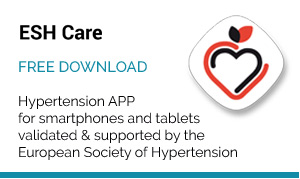Hypertension 2008
A marker of vascular health, blood pressure (BP) variability is a complex phenomenon that includes both short- and long-lasting changes. Studies have shown BP variability to be negatively associated with age, body mass index (BMI), and baroflex sensitivity and positively associated with BP level. Furthermore, high systolic BP variability, obtained every 30 minutes, is an independent predictor of cardiovascular mortality.
Current ESC/ESH guidelines state that 24-hour ambulatory BP monitoring should be considered, in particular, when
- considerable variability of office BP is found over the same or different visits;
- high office BP is measured in subjects otherwise at low total cardiovascular risk;
- there is a marked discrepancy between BP values measured in the office and at home;
- resistance to drug treatment is suspected;
- hypotensive episodes are suspected, particularly in elderly and diabetic patients;
- or when office BP is elevated in pregnant women and preeclampsia is suspected.
Conducted around the clock, ambulatory blood pressure monitoring (ABPM) provides not only 24-hour average BP, but also measures variations throughout the time period, including day and night BP profiles, day-night BP differences, morning BP rise, and BP variability. In an industry symposium, Prof. Gianfranco Parati, University of Milano-Bicocca (Italy), noted that evidence suggests that the degree to which BP fluctuates might independently contribute to organ damage and cardiovascular risk in hypertensive patients.
At night, BP falls in concert with reduced sympathetic activity, but increases sharply when an individual awakens. Evidence shows that cardiac and cerebrovascular events have a corresponding peak prevalence in the morning. This heightened BP rise in the morning is widely regarded as an adverse phenomenon that needs to be counteracted by treatment, although the goal of treatment should be to lower the overall 24-hour BP profile without interfering with physiological BP fluctuations. Other physiological changes, including heart rate, fibrinolytic activity, platelet aggregability, and circulating catecholamines, may also be considered negative co-contributors in inducing morning time cardiovascular and fatal events.
The phenomenon of a nocturnal fall in BP may vary widely, leading to the classification of hypertensive subjects whose night-time average BP falls more than 10 % of the average daytime value (“dippers”) and those in whom it falls less (“non-dippers”). In several studies, the latter group appears to experience far greater incidence of organ damage and cardiovascular events, although this has not been confirmed in other trials.
Dr. Parati said classification of “dipping” status is poorly reproducible when based on isolated occasional recordings. Also, daytime and nighttime BP values are interrelated variables and correlate similarly to organ damage, but in some groups, nighttime BP reductions have been found to be so drastic that patients are at risk of under-perfusion of organs.
Sudden, fast, and short-lasting changes that may occur during the day and – to a lesser extent – during the night contribute to BP variability. It has been shown that hypertensive patients with similar 24-hour mean BP values experience more severe organ damage when their BP variability is greater. Studies have shown that in patients with greater BP variability, overall organ damage and left ventricular mass index increase more at follow-up than in hypertensive patients with similar 24-hour BP mean values but lower BP variability.
The hypothesis can thus be made that the organ damage accompanying hypertension is in part due to the extent of BP variations. Larger prospective studies into the clinical importance of BP variability, particularly studies employing continuous ABPM techniques, are needed to determine whether BP variability represents an additional independent factor contributing to cardiovascular risk in hypertension.






